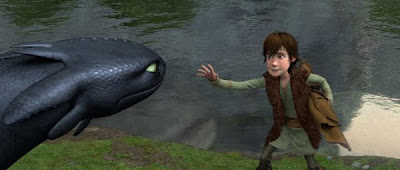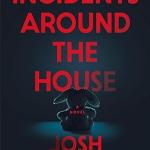
How to Train Your Dragon — considered such a disappointment when it opened over a month ago that shares in DreamWorks Animation dropped 9.2% — has shown remarkable staying power.
While the film’s grosses have dropped every week, as is standard for wide releases these days, they have dropped slower than usual — and since most of the past month’s films have done rather poorly, Dragon even “rose” back to #1 on the weekly box-office charts two weekends ago. In fact, the $15.3 million that it earned at the time now ranks as the seventh-best box-office haul that any film has had in its fifth weekend.
This must come as sweet vindication to co-director Chris Sanders, who was fired by Disney a few years ago when John Lasseter decided he didn’t like what Sanders was doing with a film called American Dog. Lasseter gave Sanders’ project to a couple other directors, and they turned it into the “Pixar Lite” movie Bolt (2008), which earned a disappointing $114.1 million in North America — but Sanders jumped to Disney’s arch-rival DreamWorks and got involved with their Dragon adaptation, and now, with $192.8 million in the till and more to come, it looks like that film could very well become DreamWorks‘ top-grossing cartoon outside of the Shrek franchise.
Why has the film been such a success? Part of the answer lies with the fact that Dragon, unlike a lot of other DreamWorks productions, “embraces sincerity over satire”, to quote Variety‘s critic — and one of the reasons the filmmakers could deviate from the studio’s formula like this is because the studio brought them in so late in the game that there was no time to second-guess their decisions, at least not to the extent that the studio normally would.
But as much as Dragon may represent a step forward for DreamWorks, there are still some critics who felt the film was a little too DreamWorksy; one such critic is animation expert Michael Barrier, who recently linked to an interesting interview with co-director Dean DeBlois and then made the following observation:
I was most intrigued by what DeBlois says about DreamWorks’ abhorrence of the “juvenile.” I’ve always thought of the DreamWorks features as jejune, but they’re not so much juvenile as adolescent. There is a much greater gulf between the juvenile and the adolescent than there is between the juvenile and the adult. Good children’s films and books deal with serious subjects as seriously as good adult films and books, but from a different perspective (particularly where relations between the sexes are concerned). Films that pander to the adolescent sensibility, like most of the DreamWorks features and all too many of today’s other movies, can’t afford to take anything seriously, except the panic that’s always threatening to erupt in the adolescent mind and that the movies treat with the soothing balm of a pervasive flipness. Carl Barks said that he thought of his readers as being around twelve years old—on the cusp of adolescence, but still children. Once children enter adolescence, with its anxieties and insecurities and consuming self-consciousness, they pass beyond the reach of artists like Barks; they’re incapable of hearing what those artists are saying until the glandular din subsides and they become adults.
The sad thing, of course, is that our culture insists on pushing the threshold of adolescence to an ever lower age. Today’s twelve-year-olds are like the fourteen- or fifteen-year-olds of the past, and children under ten are as sexualized and knowing (they think) as the teenagers of a few decades ago. Given those circumstances, it’s probably best to be grateful for what is real and honestly felt in How to Train Your Dragon, and to accept the phony bluster at the end as the price that must be paid for the remarkable few minutes when Hiccup and Toothless bridge the gap between their species.
Reading Barrier’s comments, I was reminded of two things: One, the opening paragraphs of Steven D. Greydanus’s review of Shark Tale (2004), which noted that all of the computer-animated films released by DreamWorks up to that point were like “adolescent” versions of the Pixar films of that era, sharing themes and settings but being worlds apart in terms of their attitude or, for that matter, their durability; and two, the dedication at the beginning of C.S. Lewis’s The Lion, the Witch and the Wardrobe:
My Dear Lucy,
I wrote this story for you, but when I began it I had not realized that girls grow quicker than books. As a result you are already too old for fairy tales, and by the time it is printed and bound you will be older still. But some day you will be old enough to start reading fairy tales again. You can then take it down from some upper shelf, dust it, and tell me what you think of it. I shall probably be too deaf to hear, and too old to understand, a word you say, but I shall still be
your affectionate Godfather,
C.S. Lewis
That might not be quite the same thing Barrier is talking about, perhaps, but I think it dovetails nicely with his remark that “There is a much greater gulf between the juvenile and the adolescent than there is between the juvenile and the adult.”
One last thought:
Anne Thompson recently noted that DreamWorks Animation got off to a rather rocky start, until a little film called Shrek (2001) came along and blew the competition away. Prior to that, every DreamWorks cartoon had done so-so business at best or had outright flopped, but Shrek surprised everyone by becoming the second-highest-grossing animated movie of all time, behind only The Lion King (1994).
The success of Shrek set the template that has dominated DreamWorks ever since, and it must be said that the “adolescent” films produced in its wake have been much, much better to DreamWorks’ bottom line than the films that came before. But here’s the interesting thing: according to Thompson, Shrek turned out the way it did partly because it was produced at another company, PDI, rather than in-house at DreamWorks. DreamWorks Animation chief Jeffrey Katzenberg “supervised” the production, writes Thompson, “but was not all over the animators 24/7.”
So it turns out DreamWorks Animation may owe two of its biggest successes — both the one that set the “adolescent” tone for years to come and the one that marked the first significant break away from that tone — to the fact that the studio bigwigs had less control over those films than they normally do.
There might be a lesson in that for someone, somewhere.












